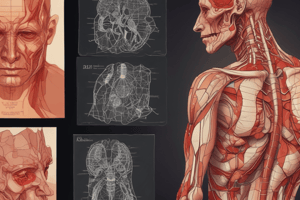Podcast
Questions and Answers
What is the relationship between the depth of a burn injury and the functional outcome for a patient?
What is the relationship between the depth of a burn injury and the functional outcome for a patient?
The deeper the burn injury, the more significant the anatomical changes to the skin and the greater the impairment to normal movement and appearance. This is especially true for full-thickness burns, which often result in severe scarring even after skin grafting.
Describe the characteristics of the zone of coagulation in a burn injury.
Describe the characteristics of the zone of coagulation in a burn injury.
The zone of coagulation is the area of most severe damage, closest to the heat source. It is characterized by protein coagulation, the presence of eschar (dead tissue), and an absence of pain due to nerve cell destruction.
Explain the significance of the zone of stasis and the risk of conversion.
Explain the significance of the zone of stasis and the risk of conversion.
The zone of stasis surrounds the zone of coagulation and contains damaged cells with impaired circulation. It is at risk of converting into the zone of coagulation if adequate resuscitation and care are not provided, leading to a deeper burn.
What are the defining features of the zone of hyperemia in a burn?
What are the defining features of the zone of hyperemia in a burn?
Why might the full extent of a burn injury not be apparent immediately after it occurs?
Why might the full extent of a burn injury not be apparent immediately after it occurs?
Flashcards
Depth of Burn Injury
Depth of Burn Injury
The severity of skin damage is linked to how deep the burn penetrates.
Zone of Coagulation
Zone of Coagulation
The area with the most severe damage, where nerve cells are destroyed and eschar forms.
Zone of Stasis
Zone of Stasis
Surrounds the zone of coagulation, characterized by damaged cells and risk of worsening injury.
Zone of Hyperemia
Zone of Hyperemia
Signup and view all the flashcards
Burn Injury Assessment Timeframe
Burn Injury Assessment Timeframe
Signup and view all the flashcards
Study Notes
Anatomical Changes in Burn Injuries
- Full-thickness burns cause significant skin changes, leading to severe scarring and impaired movement/appearance after grafting.
- Burn injury response follows concentric zones:
- Zone of coagulation: Direct heat contact, severe damage, protein coagulation, eschar formation, and lack of pain due to nerve cell destruction.
- Zone of stasis: Surrounds coagulation zone, damaged cells, impaired circulation, high risk of conversion to deeper injury (coagulation) if not properly managed.
- Zone of hyperemia: Outermost zone, increased blood flow to deliver nutrients, minimal injury, and spontaneous recovery within 1-2 weeks.
- Full injury depth might not be apparent for 24-72 hours.
- Improper resuscitation can convert the zone of stasis to coagulation.
Studying That Suits You
Use AI to generate personalized quizzes and flashcards to suit your learning preferences.



